Themed collection Luminescent silicon nanostructures

Correction: Fast room-temperature functionalization of silicon nanoparticles using alkyl silanols
Luminescent silicon nanostructures and COVID-19
This Faraday Discussion volume is unique in the hundred plus year history of the Faraday Discussion series.
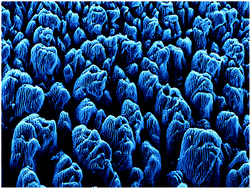
Faraday Discuss., 2020,222, 8-9
https://doi.org/10.1039/D0FD90009E
Introductory lecture: origins and applications of efficient visible photoluminescence from silicon-based nanostructures
This review highlights many spectroscopy-based studies and selected phenomenological studies of silicon-based nanostructures that provide insight into their likely PL mechanisms, and also covers six application areas.
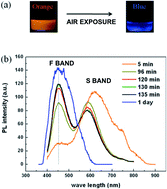
Faraday Discuss., 2020,222, 10-81
https://doi.org/10.1039/D0FD00018C
Fast room-temperature functionalization of silicon nanoparticles using alkyl silanols
We report a fast, easy and efficient method for the functionalization of hydrogen-terminated silicon nanoparticles (H-Si NPs). Using silanol compounds, a range of functionalized Si NPs could be produced in only 1 h reaction time at room temperature.
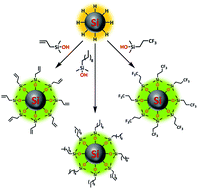
Faraday Discuss., 2020,222, 82-94
https://doi.org/10.1039/C9FD00102F
Low temperature radical initiated hydrosilylation of silicon quantum dots
Non-thermal plasma synthesized silicon QDs are functionalized with aromatic and aliphatic ligands using a 2,2′-azobis(2-methylpropionitrile) AIBN radical initiator with hydrosilylation at 60 °C for photon upconversion.

Faraday Discuss., 2020,222, 190-200
https://doi.org/10.1039/C9FD00144A
Amine functionalised silicon nanocrystals with bright red and long-lived emission
We provide a new synthetical route to obtain colloidally stable bright red and long-lived emitting silicon nanocrystals functionalised with amines.
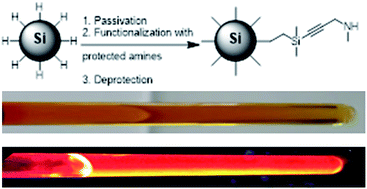
Faraday Discuss., 2020,222, 108-121
https://doi.org/10.1039/C9FD00089E
Synthesis and characterisation of isothiocyanate functionalised silicon nanoparticles and their uptake in cultured colonic cells
Isothiocyanate functionalised silicon nanoparticles were successfully synthesised for monitored drug delivery.
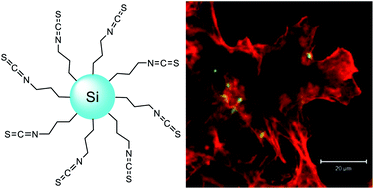
Faraday Discuss., 2020,222, 332-349
https://doi.org/10.1039/C9FD00087A
Bridging energy bands to the crystalline and amorphous states of Si QDs
The relationship between crystallization process and opto-electronic properties of silicon quantum dots (Si QDs) synthesized by atmospheric pressure plasmas (APPs) is studied.
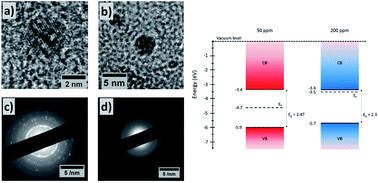
Faraday Discuss., 2020,222, 390-404
https://doi.org/10.1039/C9FD00103D
Shedding light on the aqueous synthesis of silicon nanoparticles by reduction of silanes with citrates
The synthesis in water of silicon nanoparticles yields to an emissive carbon/silica composite.
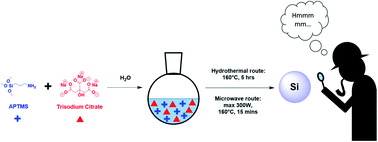
Faraday Discuss., 2020,222, 350-361
https://doi.org/10.1039/C9FD00127A
Modulating donor–acceptor transition energies in phosphorus–boron co-doped silicon nanocrystals via X- and L-type ligands
We explore the effect of ligand binding groups on the photoluminescent properties of phosphorus–boron co-doped silicon nanocrystals (PB:Si NCs) by exploiting X-type (covalent) and L-type (Lewis donor molecule) bonding interactions.
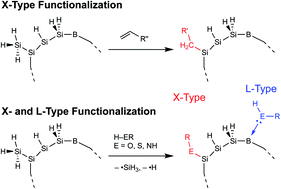
Faraday Discuss., 2020,222, 201-216
https://doi.org/10.1039/C9FD00106A
Luminescent silicon nanoparticles for distinctive tracking of cellular targeting and trafficking
We demonstrate tracking of silicon nanoparticles through intrinsic photoluminescence during the course of cellular targeting and uptake.
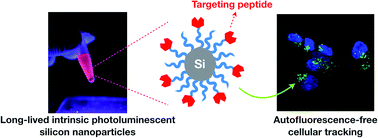
Faraday Discuss., 2020,222, 304-317
https://doi.org/10.1039/C9FD00124G
The next big thing for silicon nanostructures – CO2 photocatalysis
Silicon nanostructures for the catalytic conversion of CO2 to value-added products.
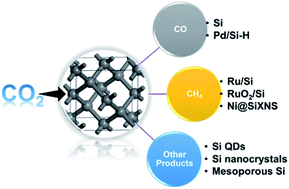
Faraday Discuss., 2020,222, 424-432
https://doi.org/10.1039/C9FD00104B
Silicon photosensitisation using molecular layers
Silicon photosensitisation via energy transfer from molecular dye layers is a promising area of research for excitonic silicon photovoltaics.
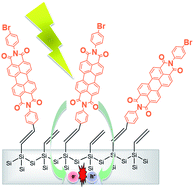
Faraday Discuss., 2020,222, 405-423
https://doi.org/10.1039/C9FD00095J
The shell matters: one step synthesis of core–shell silicon nanoparticles with room temperature ultranarrow emission linewidth
Here we present a one-step synthesis that provides silicon nanocrystals with a thin shell composed of a ceramic-like carbonyl based compound, embedded in a porous organosilicon film.
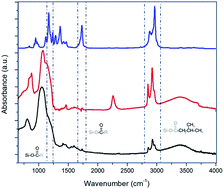
Faraday Discuss., 2020,222, 135-148
https://doi.org/10.1039/C9FD00093C
Power-dependent photoluminescence decay kinetics of silicon nanocrystals under continuous and pulsed excitation
Power-dependent photoluminescence (PL) decay kinetics of silicon nanocrystals (Si NCs) in solid and liquid samples were studied under cw and pulsed excitation.
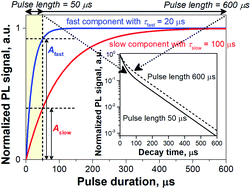
Faraday Discuss., 2020,222, 274-293
https://doi.org/10.1039/C9FD00100J
Critical assessment of wet-chemical oxidation synthesis of silicon quantum dots
The wet-chemical Si QD synthesis by oxidation of magnesium silicide (Mg2Si) with bromine (Br2) was revisited.
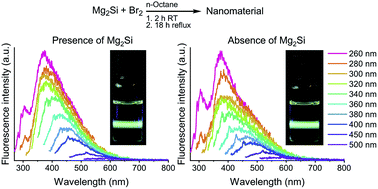
Faraday Discuss., 2020,222, 149-165
https://doi.org/10.1039/C9FD00099B
The effects of drying technique and surface pre-treatment on the cytotoxicity and dissolution rate of luminescent porous silicon quantum dots in model fluids and living cells
Tailoring of the cytotoxicity and dissolution rate of luminescent porous silicon quantum dots is presented.
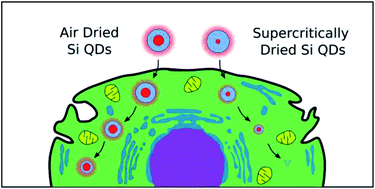
Faraday Discuss., 2020,222, 318-331
https://doi.org/10.1039/C9FD00107G
Tight-binding calculations of the optical properties of Si nanocrystals in a SiO2 matrix
We develop an empirical tight binding approach for the modeling of the electronic states and optical properties of Si nanocrystals embedded in a SiO2 matrix.
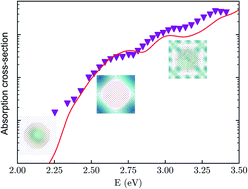
Faraday Discuss., 2020,222, 258-273
https://doi.org/10.1039/C9FD00090A
Dual-emission fluorescent silicon nanoparticle-based nanothermometer for ratiometric detection of intracellular temperature in living cells
We present a dual-emission fluorescent nanothermometer, which is made of europium-doped silicon nanoparticles, allowing the detection of intracellular temperature.
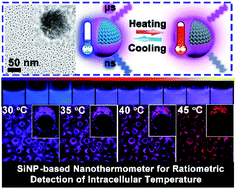
Faraday Discuss., 2020,222, 122-134
https://doi.org/10.1039/C9FD00088G
The red and blue luminescence in silicon nanocrystals with an oxidized, nitrogen-containing shell
Upon exposure to nitrogen, blue photoluminescence of silicon nanocrystals is observed to diminish, while red photoluminescence is preserved.

Faraday Discuss., 2020,222, 240-257
https://doi.org/10.1039/C9FD00092E
Ab initio studies of the optoelectronic structure of undoped and doped silicon nanocrystals and nanowires: the role of size, passivation, symmetry and phase
Results from ab initio calculations for singly- and co- doped Si nanocrystals and nanowires are presented.
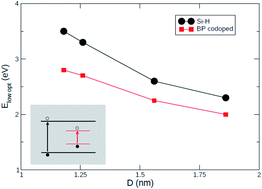
Faraday Discuss., 2020,222, 217-239
https://doi.org/10.1039/C9FD00085B
Photophysical properties of ball milled silicon nanostructures
High-energy ball milling was used to synthesize blue-green emitting Si nanocrystals from micron sized silicon particles.
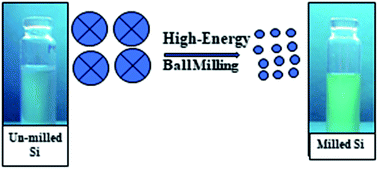
Faraday Discuss., 2020,222, 96-107
https://doi.org/10.1039/C9FD00105K
The influence of hydrofluoric acid etching processes on the photocatalytic hydrogen evolution reaction using mesoporous silicon nanoparticles
In this work, the response of the photocatalytic activity of mp-Si nanoparticles to a series of HF acid treatments was investigated.
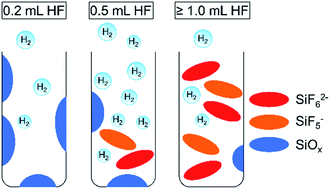
Faraday Discuss., 2020,222, 176-189
https://doi.org/10.1039/C9FD00098D
Ultrasmall silicon nanoparticles as a promising platform for multimodal imaging
Biocompatible ultrasmall silicon nanoparticles (2.4 ± 0.5 nm) equipped with both a near-infrared dye and a radiolabel provide reliable information about biodistribution and pharmacokinetic properties.
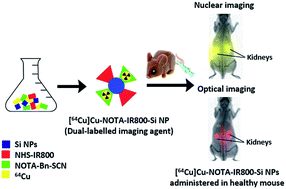
Faraday Discuss., 2020,222, 362-383
https://doi.org/10.1039/C9FD00091G
Synthesis and functionalisation of silicon nanostructures: general discussion
Faraday Discuss., 2020,222, 166-175
https://doi.org/10.1039/D0FD90004D
Silicon nanostructures for sensing and bioimaging: general discussion
Faraday Discuss., 2020,222, 384-389
https://doi.org/10.1039/D0FD90006K
Silicon nanostructures for energy conversion and devices: general discussion
Faraday Discuss., 2020,222, 433-435
https://doi.org/10.1039/D0FD90007A
Optical and electronic properties: from theory to experiments: general discussion
Faraday Discuss., 2020,222, 294-303
https://doi.org/10.1039/D0FD90005B
About this collection
We are delighted to share with you a selection of the papers associated with a Faraday Discussion on Luminescent silicon nanostructures.
Silicon is the most important semiconducting material of the microelectronic industry. Bulk silicon does not exhibit good optical properties, however in the late 1980s good emission was observed and studied in a silicon-based material, porous silicon. Since then, a variety of luminescent silicon nanostructures have been investigated, but different results and interpretations have been reported in the literature regarding the origin of the luminescence of these structures.
This Faraday Discussion covers new methodologies to synthesize and characterise luminescent silicon nanostructures, from porous silicon to nanocrystals and nanorods. Attention is devoted to the most promising applications of these systems in the fields of bioimaging, sensing and energy conversion (e.g., OLED and luminescent solar concentrators). Wet, dry, chemical, physical, thermal and out-of-equilibrium formation paths will be related to the physics of the produced nanostructures and to the role of the matrix (interface) in which they are embedded.